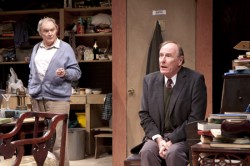“The majority of people perform well in a crisis and when the spotlight is on them; it’s on the Sunday afternoons of this life, when nobody is looking, that the spirit falters.”
Alan Bennett, Writing Home
Archives for 2011
TT: The boys are back
In today’s Wall Street Journal I review the American premiere of The Habit of Art, Alan Bennett’s latest play, at Washington’s Studio Theatre. Here’s an excerpt.
* * *
Alan Bennett has a knack for writing big, complicated plays that are, like “The History Boys” and “The Madness of George III,” both challenging and entertaining. “The Habit of Art,” a fictional portrayal of the uneasy relationship between W.H. Auden and Benjamin Britten, fills the bill on all counts. Though the scale of the play (one set, two acts) is modest, “The Habit of Art” sprawls all over the place. But Mr. Bennett’s latest play is so excitingly written that you won’t find it hard to forgive its failings, and Washington’s Studio Theatre has given it a production so polished that it could open on Broadway as is.
 “The Habit of Art” is set at a rehearsal of “Caliban’s Day,” an imaginary docudrama about Auden, Britten and Humphrey Carpenter, who wrote biographies of both men. In the play-within-the-play, the fictional Carpenter (Cameron Folmar) pays a visit to the fictional Auden (Ted van Griethuysen) to interview him about the fictional Britten (Paxton Whitehead). Then Britten pays a visit to Auden, whom he hasn’t seen in person for 20 years, to ask the poet’s advice about the operatic version of “Death in Venice” on which he is working. Their awkward reunion is interrupted by the arrival of a young male prostitute (Randy Harrison) who has a date with Auden and in whom Britten takes a furtive interest.
“The Habit of Art” is set at a rehearsal of “Caliban’s Day,” an imaginary docudrama about Auden, Britten and Humphrey Carpenter, who wrote biographies of both men. In the play-within-the-play, the fictional Carpenter (Cameron Folmar) pays a visit to the fictional Auden (Ted van Griethuysen) to interview him about the fictional Britten (Paxton Whitehead). Then Britten pays a visit to Auden, whom he hasn’t seen in person for 20 years, to ask the poet’s advice about the operatic version of “Death in Venice” on which he is working. Their awkward reunion is interrupted by the arrival of a young male prostitute (Randy Harrison) who has a date with Auden and in whom Britten takes a furtive interest.
Around this more than sufficiently intriguing situation, Mr. Bennett has wrapped a backstage comedy about the process of rehearsing “Caliban’s Day” for production at London’s National Theatre. In addition to the cast of “Caliban’s Day,” we meet the vain, neurotic playwright (Wynn Harmon), the long-suffering stage manager (Margaret Daly) and various other familiar but knowingly drawn theatrical types. Imagine “Noises Off” rewritten by Tom Stoppard and you’ll get some notion of the havoc arising from the collision of play and play-within-a-play….
The rehearsal-room sequences of “The Habit of Art” are totally convincing, so much so that the play seems in the end to be more about theater itself than about Auden and Britten. The problem is that the contrast between Auden’s self-acceptance and Britten’s “occluded sexuality” (in Auden’s phrase) is the emotional engine that drives “The Habit of Art,” and Mr. Bennett has not made it dramatically compelling. Yet even when it falters, “The Habit of Art” holds your attention, and David Muse’s staging is so clearly articulated and full of crisp comic energy that you’ll have no difficulty picking your way through the thickets of Mr. Bennett’s labyrinthine plot….
* * *
Read the whole thing here.
TT: Almanac
“Argument is generally waste of time and trouble. It is better to present one’s opinion and leave it to stick or no as it may happen. If sound, it will probably in the end stick, and the sticking is the main thing.”
Samuel Butler, The Note-Books of Samuel Butler
TT: So you want to see a show?
Here’s my list of recommended Broadway, off-Broadway, and out-of-town shows, updated weekly. In all cases, I gave these shows favorable reviews (if sometimes qualifiedly so) in The Wall Street Journal when they opened. For more information, click on the title.
BROADWAY:
• Anything Goes (musical, G/PG-13, mildly adult subject matter that will be unintelligible to children, closes Jan. 8, most performances sold out last week, reviewed here)
• Follies (musical, PG-13, adult subject matter, closes Jan. 1, most performances sold out last week, reviewed here)
• How to Succeed in Business Without Really Trying (musical, G/PG-13, perfectly fine for children whose parents aren’t actively prudish, reviewed here)
OFF BROADWAY:
• Avenue Q (musical, R, adult subject matter and one show-stopping scene of puppet-on-puppet sex, reviewed here)
• The Fantasticks (musical, G, suitable for children capable of enjoying a love story, reviewed here)
• Million Dollar Quartet (jukebox musical, G, off-Broadway remounting of Broadway production, original run reviewed here)
IN ASHLAND, OREGON:
• August: Osage County (drama, PG-13/R, closes Nov. 5, reviewed here)
• Julius Caesar (Shakespeare, PG-13, closes Nov. 6, reviewed here)
• Measure for Measure (Shakespeare, PG-13, closes Nov. 6, reviewed here)
CLOSING SOON IN ASHLAND, OREGON:
• The Pirates of Penzance (operetta, G, suitable for children, closes Oct. 8, reviewed here)
CLOSING SOON IN HARTFORD, CONNECTICUT:
• The Crucible (drama, PG-13, partial nudity, extended through Oct. 6, reviewed here)
CLOSING SOON IN WASHINGTON, D.C.:
• Oklahoma! (musical, G, remounting of 2010 production, suitable for children, closes Oct. 2, original run reviewed here)
CLOSING NEXT WEEK IN SPRING GREEN, WISCONSIN:
• The Tempest (Shakespeare, G/PG-13, closes Sept. 30, reviewed here)
CLOSING SUNDAY IN SPRING GREEN, WISCONSIN:
• The Cure at Troy (Greek tragedy, G, far too intense for children, reviewed here)
TT: Almanac
“Men are seldom more commonplace than on supreme occasions.”
Samuel Butler, The Note-Books of Samuel Butler
TT: Comfort and joy
This summer has been far too much of a muchness: too much travel, too much work, too much stress. Mrs. T and I had planned to take a week off, but our plan was scrapped when my mother fell ill, and I ended up going straight from reviewing shows all over the country to opening one of my own in Florida. By the time I arrived in Washington, D.C., on Monday, I was as frazzled as I’ve ever been.
 Fortunately, the friend with whom I had dinner that evening took one look at me and insisted that I do something just for fun as soon as humanly possible, so I strolled over to the Phillips Collection the next day and spent an hour looking at paintings. Not only had a month gone by since my last walk–that’s how busy I’ve been–but I hadn’t set foot in my favorite museum for two years. It wasn’t that I’d forgotten how much I love the Phillips, but I confess to having been startled by how comforting it was for me to visit its galleries after so prolonged an absence. No sooner did I find my way to Paul Klee’s Arrival of the Jugglers than I felt the world start to right itself.
Fortunately, the friend with whom I had dinner that evening took one look at me and insisted that I do something just for fun as soon as humanly possible, so I strolled over to the Phillips Collection the next day and spent an hour looking at paintings. Not only had a month gone by since my last walk–that’s how busy I’ve been–but I hadn’t set foot in my favorite museum for two years. It wasn’t that I’d forgotten how much I love the Phillips, but I confess to having been startled by how comforting it was for me to visit its galleries after so prolonged an absence. No sooner did I find my way to Paul Klee’s Arrival of the Jugglers than I felt the world start to right itself.
Henri Matisse made an oft-quoted remark about his art that deserves closer consideration than it tends to get:
What I dream of is an art of balance, of purity, and tranquility, without any disquieting or preoccupying subject matter, an art that could be for every mental worker, for the businessman as well as the man of letters, for example, a tonic, a cerebral calmative, something like a good armchair that relaxes him from his physical fatigue.
Those of us who spend our lives immersed in the world of art have an unfortunate way of overlooking its unique ability to serve as a remedy for the trials of life. We think of art as something to do, not something to use, and many of us also suffer from the mistaken notion that art must be challenging in order to be good. On some level, of course, that’s perfectly true, but there are many different ways of experiencing art, all of which are valid as far as they go. (There are nine and sixty ways of constructing tribal lays,/And every single one of them is right!) To take uncomplicated pleasure from beauty is a wholly worthy activity, and to do it in the hope of finding surcease from whatever may be troubling us is no less worthy.
 One of the reasons why I love the Phillips is because it never fails to surprise me. Today I ran across a small untitled painting by Franz Kline that I’d never seen before, and I delighted in its unpredictability. Who knew that Kline, that most monochromatic of modernists, could make such startling use of color? But I’d come to the Phillips to rest my spirit, and as I gazed at The Open Window and The Garden at Les Lauves for the umpteenth time, I felt the calm of which Matisse spoke, the comfort of great art whose idiosyncrasies are as familiar as the quirks of an old friend.
One of the reasons why I love the Phillips is because it never fails to surprise me. Today I ran across a small untitled painting by Franz Kline that I’d never seen before, and I delighted in its unpredictability. Who knew that Kline, that most monochromatic of modernists, could make such startling use of color? But I’d come to the Phillips to rest my spirit, and as I gazed at The Open Window and The Garden at Les Lauves for the umpteenth time, I felt the calm of which Matisse spoke, the comfort of great art whose idiosyncrasies are as familiar as the quirks of an old friend.
I returned to the hotel refreshed, took a nap, then went to the Studio Theatre to see a new play, one to whose newness I would surely have been unequal had I not spent the afternoon communing with Bonnard and Cézanne. Today I return to Connecticut and Mrs. T, and I dare say I’ll appreciate her even more than usual, too. There are worse reasons to go to museums–or to make art.
TT: Snapshot
Home movies of Arnold Schoenberg, taken in 1937 by George Gershwin:
(This is the latest in a weekly series of arts-related videos that appear in this space each Wednesday.)
TT: Almanac
“The composer is seldom a great theorist; the theorist is never a great composer. Each is equally fatal to and essential in the other.”
Samuel Butler, The Note-Books of Samuel Butler
